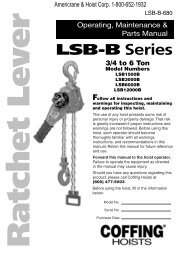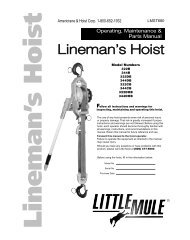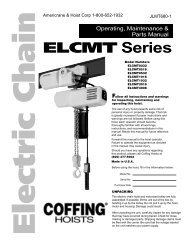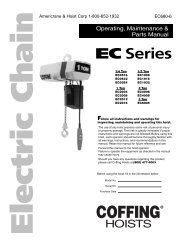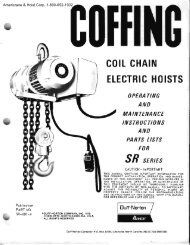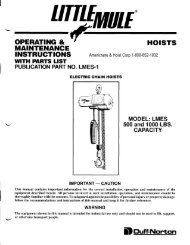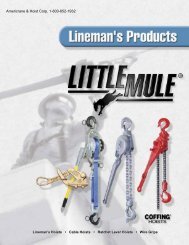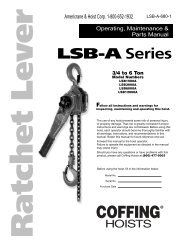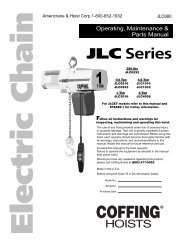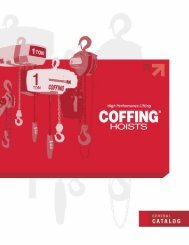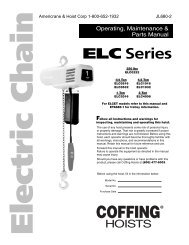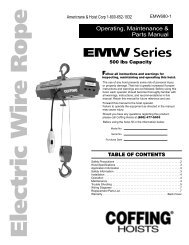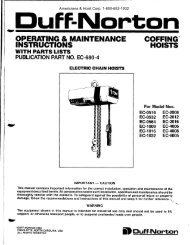MA Series part 1 - Coffing Hoists, Coffing Hoist Parts
MA Series part 1 - Coffing Hoists, Coffing Hoist Parts
MA Series part 1 - Coffing Hoists, Coffing Hoist Parts
- No tags were found...
Create successful ePaper yourself
Turn your PDF publications into a flip-book with our unique Google optimized e-Paper software.
IiSECTION IVIt'IAINTENANCE4-1. INSPECTIOI{S.4-2. A planned inspection routine should be establishedfor this hoist based upon frequency of use,severity of use, and environmental conditions. Someinspections should be made frequently (daily to monthly)and others periodically (monthly to yearly). It isstrongly recommended that an Inspection and MaintenanceCheck List and an Inspector's Report similiarto those shown in figures 4-4 and 4-5 be used andfiled for reference. All inspections should be made by,or under the direction of a designated inspector.Special inspections should be made following anysignificant repairs or any operating occurence leadingone to suspect that the hoist's capabilities may havebeen impaired. Refer to paragraphs 4-13 and 4-25 forassistance in any disassembly and assembly necessaryfor inspections and subsequent replacementor repair. Prior to inspection, clean <strong>part</strong>s as required.See paragraph 4-21.4_3. FREOUENT INSPECTIONS.4-4. Perform the following inspections daily prior toinitial use of the hoist. Also, observe during operationfor any damage which might appear between regularinspections.CAUTION: Any unsafe condition disclosed by the inspectionshall be corrected before operation of thehoist is resumed. Adjustments and repairs shall bedone only by designated personnel.a. Inspect the hooks for deformations, chemicaldamage or cracks. Hooks damaged by chemicals, deformationor cracks, or having throat openings greaterthan the "Maximum Allowable Opening" shown in figure4-1 must be replaced. If the hook is twisted morethan 10 degrees from the plane of the unbent hook, itmust be replaced.Note: Any hook that is twisted or has throat openingsin excess of those listed in figure4-1 indicates abuseTHROAT OPENING(w,/o LATCH)HOISTREJECT HOOK OPENINGMODEL NO.TOP HOOK BOTTOM HOOK<strong>MA</strong>-15 r-7 /32" r-7/32"<strong>MA</strong>-15-2 r-7 /32" L-7 /32"<strong>MA</strong>-15-2W r-7 /32" r-7 /32"<strong>MA</strong>_30 r-13/32" r-r3/32"<strong>MA</strong>-30-2 r-3/ 4" r-3/ 4"<strong>MA</strong>-30-2W r-3/4" r-3/ 4"<strong>MA</strong>-30-3 2-S/32" 2-5/32"<strong>MA</strong>-30-4 2-s/32" 2-5/32"FIGURE 4-1. HOOK THROAT OPENINGor overloading of the hoist. Other load bearing componentsshould be inspected accordingly.b. Check that both hooks swivel freely.c. Check the hoist handle for bends. If the handleis bent, the hoist has probably been highlyoverloaded. A qualified service man should inspebtthe hoist for other damage or return the hoist to thefactory.d. Check load chain for wear, twist and distortion_and ensure that dead end ring or connection issecure. Also check the chain for presence of foreignmaterial and adequate lubrication.4-5. PERTODIC INSPECTIONS.4-6. It is recommended that the following inspectionsbe performed at one to 12 month intervals. The exactperiod of inspection will depend on frequency and typeof usage. Determination of this period will be basedon the user's experience. It is recommended that theuser begin with a monthly inspection and extend theperiods to quarterly, semi-annually or annually basedon his monthly experience.CAUTION: Any unsafe condition disclosed by theinspection shall be corrected before operation of thehoist is resumed. Adjustments and repairs shall bedone only by designated personnel.a. Perform all the frequent inspections listedin paragraph 4-4.b. Check nuts. bolts and other hardware forlooseness, stripped or damaged threads.c. Check load sheave and chain attachmentsfor distortion, cracks and excessive wear.d. Check pawls for excessive wear, bindingand missing or broken pins.e. Check pawl springs for breaks, corrosionand continued ability to hold pawl properly:f. Check load pawl shaft for excessive wear.g. Inspect gear and pinion shaft for adequatelubrication, cracks, distortion, worn or broken teeth.h. Inspect bearings for adequate lubrication,distortion. cracks and excessive wear.i. Check housing, covers, swivel frames, loadblocks and outrigger for cracks and distortion.j. Inspect hub for damage to threads. Checkhub and thrust washer for scoring or other damage tobraking surfaces.k. Check brake discs for excessive wear,glazing or oil contamination. Replace discs worn to athickness of 5/64 inch or less.l. Inspect seals, "o" rings an! gaskets fordeterioration and wear.m. Inspect decal and capacity plate forlegibility.n. Inspect supporting structure for continuedability to support imposed loads.o. Inspect the chain for gouges, nicks, weldsplatter, corrosion and distorted links. Slacken thejtIf,lAmericrane & <strong>Hoist</strong> Corp 1-800-652-1932



